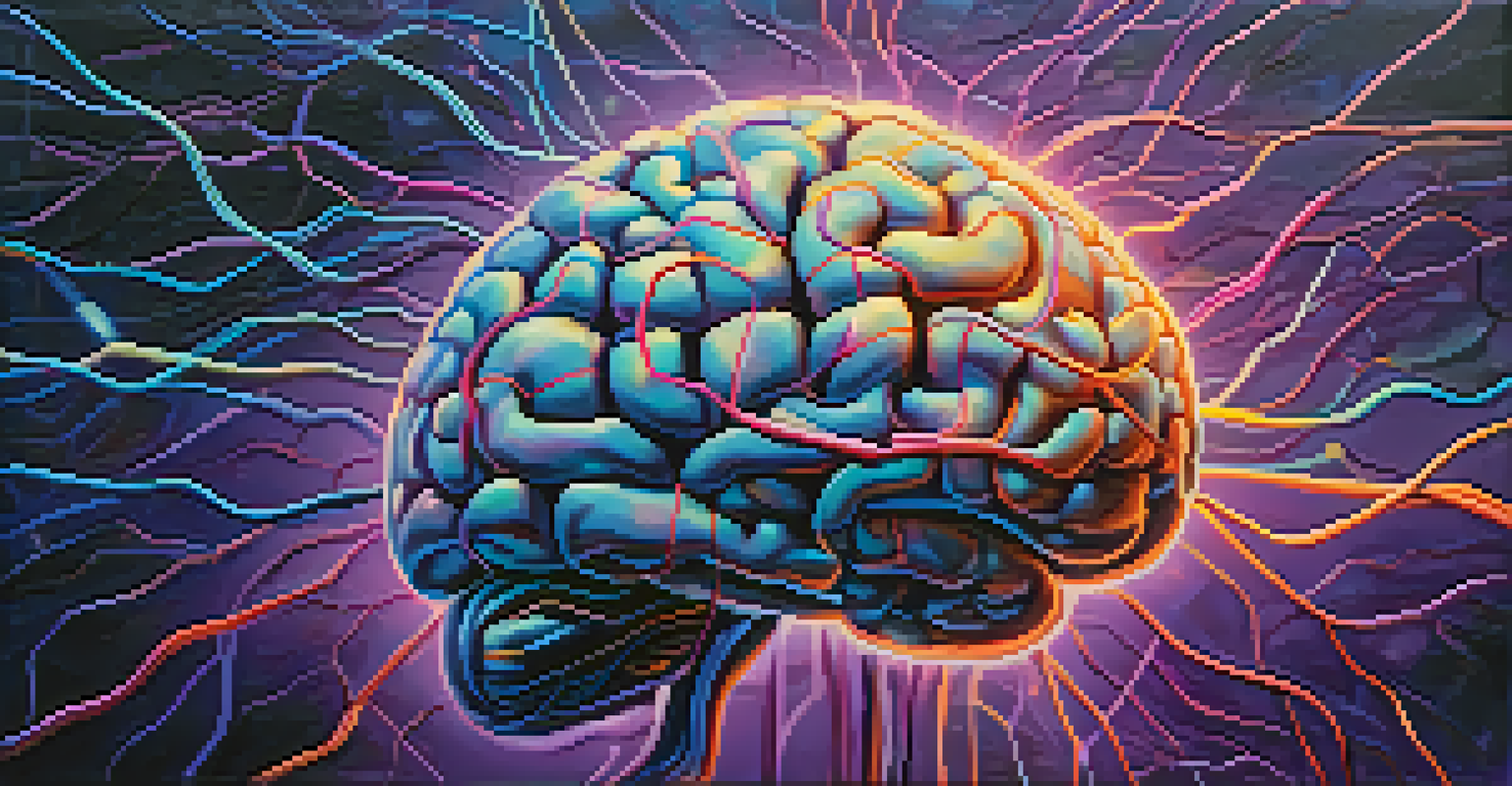The Science Behind Entheogens and Emotional Aging

Understanding Entheogens: A Brief Overview
Entheogens are natural substances, often derived from plants, that have been used in various cultures for spiritual and therapeutic purposes. These substances can alter consciousness, potentially leading to profound emotional experiences. Common examples include psilocybin from mushrooms and ayahuasca, a brew from the Amazon rainforest. Understanding entheogens starts with recognizing their historical significance and the ways they have been utilized across different societies.
The use of entheogens can lead to transformative insights, helping individuals confront and process unresolved emotional issues.
The term 'entheogen' itself comes from Greek roots meaning 'generating the divine within.' This indicates not just a chemical experience but a potential spiritual awakening. As we delve deeper into their effects, it becomes essential to consider how these experiences might influence our emotional landscape, particularly as we age. By exploring the intersection of entheogens and emotional well-being, we can uncover insights into their therapeutic potential.
In recent years, there has been a resurgence of interest in the scientific study of entheogens, especially regarding mental health and emotional resilience. Researchers are investigating how these substances can alter brain chemistry and emotional responses, leading to a better understanding of their benefits. As we explore this relationship, it paves the way for more informed discussions about their role in emotional aging.
The Mechanisms of Entheogens in the Brain
Entheogens primarily affect the brain's serotonin receptors, particularly the 5-HT2A receptor, which plays a crucial role in mood regulation and perception. When these receptors are activated, they can lead to alterations in consciousness and emotional states. This interaction can promote feelings of connection, introspection, and even emotional release, which are vital for emotional health as we age.

Research has shown that entheogens can stimulate neuroplasticity—the brain's ability to reorganize itself by forming new neural connections. This plasticity is particularly important for older adults, as it may help combat cognitive decline and emotional stagnation. By fostering new patterns of thought and emotion, entheogens can play a role in reshaping our emotional narratives, allowing for healthier aging.
Entheogens Enhance Emotional Healing
Entheogens can promote emotional resilience and help individuals confront unresolved issues, particularly beneficial for older adults.
Moreover, the profound experiences often induced by entheogens can lead to transformative insights, helping individuals confront and process unresolved emotional issues. This emotional catharsis can be particularly beneficial for older adults who may carry years of accumulated stress or trauma. Understanding these mechanisms highlights the potential of entheogens as tools for emotional healing and growth.
The Role of Entheogens in Emotional Resilience
Emotional resilience refers to the ability to adapt to stress and adversity, a skill that often becomes more crucial as we age. Entheogens can enhance this resilience by promoting profound experiences that encourage individuals to reevaluate their perspectives on life. By fostering a deeper understanding of oneself and the world, these substances can help individuals develop a more robust emotional toolkit.
Creating a safe and supportive environment can significantly enhance the potential benefits of entheogens.
For example, many people report experiencing a sense of interconnectedness with others and nature during entheogenic journeys, which can mitigate feelings of isolation and loneliness. This is particularly important for older adults who may face social isolation. By enhancing feelings of connection, entheogens can play a vital role in promoting emotional well-being and resilience.
Furthermore, the insights gained during these experiences can lead to lasting changes in attitude and behavior. When individuals confront their fears or grief in a supportive environment, they often emerge with a renewed sense of purpose and clarity. This transformative potential underscores the importance of integrating entheogens into discussions about emotional health in aging.
Exploring the Therapeutic Applications of Entheogens
The therapeutic applications of entheogens have gained traction in recent years, with studies suggesting their efficacy in treating various mental health conditions, including depression and anxiety. As we age, these conditions can become more prevalent, making the exploration of alternative treatments necessary. Entheogens, when used in a controlled and supportive setting, have the potential to provide relief and promote emotional healing.
Clinical trials are increasingly focusing on the use of substances like psilocybin for treating end-of-life anxiety and depression in terminally ill patients. The results have been promising, indicating that these substances can lead to significant improvements in emotional well-being. This opens the door to considering entheogens as viable options for enhancing emotional health in older adults.
Cultural Insights Shape Use Practices
Understanding cultural perspectives on entheogens can guide ethical practices and integration into modern therapeutic settings.
Additionally, the integration of psychotherapy with entheogenic experiences can further amplify their therapeutic effects. This combination allows individuals to process their emotions and experiences in real-time, leading to deeper healing. As the scientific community continues to explore these applications, the potential for entheogens to enhance emotional aging becomes increasingly clear.
Cultural Perspectives on Entheogens and Aging
Throughout history, various cultures have embraced the use of entheogens to facilitate emotional and spiritual growth. Indigenous communities, for instance, have long recognized the value of these substances in rituals and healing practices. Understanding these cultural perspectives can provide valuable insights into how entheogens may serve as tools for emotional aging in contemporary society.
In many cultures, the use of entheogens is intertwined with rites of passage and community bonding, emphasizing the role of social support in emotional well-being. As we consider how these practices can be adapted for modern use, it’s essential to honor the traditions and values of those who have used these substances for centuries. This respect can help guide ethical practices in the exploration of entheogens.
Moreover, the growing interest in psychedelic therapy often overlooks the rich cultural histories associated with these substances. By acknowledging and integrating these perspectives into our discussions, we can create a more holistic understanding of how entheogens can benefit emotional aging, fostering a deeper connection between past wisdom and contemporary science.
Safety Considerations: The Importance of Set and Setting
While entheogens present exciting possibilities for emotional aging, safety should always be a priority. The concept of 'set and setting' refers to the mindset of the individual and the physical environment in which the experience takes place. Both of these elements play a crucial role in determining the outcome of an entheogenic experience, especially for older adults who may be more vulnerable.
Creating a safe and supportive environment can significantly enhance the potential benefits of entheogens. This includes having trained facilitators present, ensuring emotional support, and providing a comfortable space. For older adults, who might have specific health concerns or emotional sensitivities, these factors become even more critical for a positive experience.
Safety is Key in Entheogenic Use
Prioritizing 'set and setting' is crucial for ensuring positive outcomes and minimizing risks when using entheogens, especially for older adults.
Furthermore, it's essential to consider the potential interactions between entheogens and medications commonly used by older adults. Consulting with healthcare professionals who understand both the benefits and risks of entheogens can help individuals make informed choices. By prioritizing safety, we can better explore the therapeutic potential of these substances while minimizing risks.
Future Directions: Research and Integration of Entheogens
As the conversation around mental health and emotional well-being continues to evolve, the potential role of entheogens in enhancing emotional aging is gaining attention. Ongoing research is crucial to deepen our understanding of how these substances can be effectively integrated into therapeutic settings. This includes not only studying their effects but also exploring best practices for their use among older adults.
Future studies may focus on long-term impacts of entheogenic experiences on emotional health and aging. Understanding how these experiences influence emotional resilience and cognitive function over time will be vital in developing comprehensive treatment options. Additionally, interdisciplinary collaboration among scientists, therapists, and cultural practitioners can lead to more holistic approaches.

Ultimately, the integration of entheogens into mental health care could pave the way for innovative treatments that address the unique emotional challenges faced by older adults. As we continue to explore this fascinating intersection of science and spirituality, the potential for entheogens to positively impact emotional aging becomes increasingly promising.